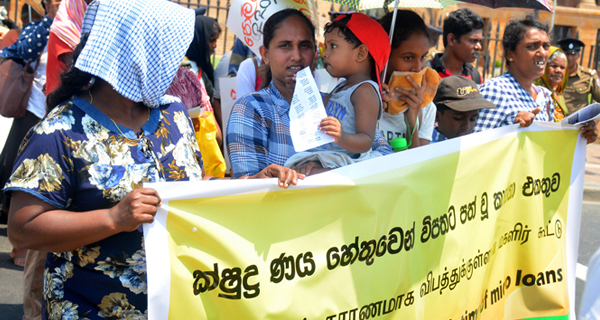In Nuwara Eliya, a woman has taken a loan to sew clothes. She and her husband have planned to go more far place like Pamunuwa and bring clothes. But while they were doing this, Hasban’s arm broke and she was unable to carry on her business. That’s where their problems start. One dairy cow has died while running a dairy business. This cow dies about six months after taking a loan. I ‘ve come across a lot of stories like this. These people take out loans to start a business, but they start repaying the loans within the next week or next month. So this credit scheme exists without leaving any time for people to generate any income from it. That’s a big mess. As a result, people end up stuck in debt, unable to pay their debts.
What is a microfinance loan?
Microfinance loans are loans given to home businesses with the aim of creating an entrepreneur. People take these loans in the hope of improving what they are doing. I think they have no idea about the seriousness of the loan but they need money. They think that they will be able to repay the loan. I am asking for a loan to do economic activity. I need 100,000 rupees for that economic activity. But they also give me loans either by deducting the first installment or by deducting the insurance. I did not receive total Rs.100,000. Then I did not get a loan that suited my needs. The rest of the money has to be taken from the moneylender either. Or I did not receive the loan on time. So I take a loan from a moneylender and then pay it off.
Things like climate change are also an obstacle to repaying these loans, aren’t they?
Climate change is a problem facing farmers and fishermen. Months ago when I went to Kilinochchi, a co-operative officer told me that the weather was not as good as it used to be but that climate change was happening very short period of time. That is a big problem for farmers. Like I said before, they plan to pay for this with their income. But without realizing it, interest and fines add up. Then, as soon as something happens, the financial institutions start levying fines and related things. So people have to pay off debts. People say that if we take a loan, we have to pay it back. So, to settle the matter, take a loan from another company, institution, or moneylender. Or at least take a loan from a neighbor.
What classes of people were the debtors? Is the loan amount sufficient?
This group is mostly farmers, fishermen or women who make small products at home. We know that when it comes to fishing, a lot of people go to sea, not women, but their husbands. But this is not an economic activity that husbands do alone. That is what farming is all about. These are family-related economic activities. So people go into debt with the hope of improving what they are doing. They don’t think about the rules. They believe that they can repay the loan with the income they earn. Some installments are weekly installments, some are monthly installments.
Is the popular opinion about micro finances true?
Microfinance is a system recognized by the United Nations, the World Bank, the Asian Development Fund and other such organizations at the international level. We acknowledge that this is a process that empowers women to eradicate poverty. The Nobel Peace Prize is awarded to Mohamed Younis and the Grameen Bank model who introduced the micro finance system to eradicate poverty in 2006. So it shows us how much this has been accepted. As I recall, the following year was designated by the United Nations as the Year of Microfinance. One of the issues we are facing today is the popularity of micro finances.
Even though men are in Sri Lanka all over the world, there is still a great deal to be done in the face of the perception that women have played a major role in economically empowering and alleviating poverty. Many people have been surveyed by anthropologists, sociologists and economic scientists. One example is the research done by Amino Rahuman on the village of Bangladesh, which was the basis for Mohamed Younis to experiment with the Grameen banking system earlier. He has shown that even in that village this has not really happened.
How is the situation in Sri Lanka?
Large-scale attention was paid to this microfinance crisis, with the intervention of women, women’s organizations and cooperatives in the North, with people taking to the streets and campaigning against it. At that time the government also had to intervene in this issue. The main event was the 2018 debate in Parliament on micro finance. One of the issues raised in the parliamentary debate is that by 2018, there will be around 168 women committing suicide. This situation has escalated.
